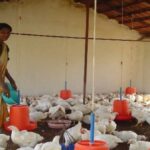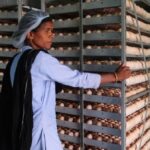Being a valley ensconced between the Kalvarayan and Sitteri Hills, Sittilingi is quite cut off from the rest of Dharmapuri District under which it falls. With limited access, the valley would seem safe from the rapid spread of coronavirus.
However, monsoon failure force the farming tribes to migrate to towns and cities in Tamil Nadu and the neighboring state of Kerala, in search of livelihood. Some go to Bengaluru and Mumbai. With the possible risk of returning migrants bringing the virus, the Sittilingi panchayat took various precautionary measures.
While precautionary measures against the viral disease have been more self-induced in cities, in Sittilingi Valley, a proactive panchayat leadership has rallied the community around to safeguard itself, through systematic planning.
Planning meet
Sittilingi panchayat has 24 villages under its administration. Malaivasi tribes make up the majority of the 15,000-odd population. Nomadic Lambadi tribes from Rajasthan and Gujarat also settled here long ago, in villages known as thanda.
As the first step towards taking precautionary steps, Madheswari, who was sworn in as the panchayat president in January, convened a meeting.
A team from the government primary health center that was started two years ago, a team from Tribal Hospital of Tribal Health Initiative that has been fulfilling the medical needs of the valley and its surrounds since 1992, besides panchayat members and village administrative officers, attended the meeting.
“We chalked out plans to take the message to the villagers, follow government’s directions, inform residents about the precautionary measures to be taken by them as well as by returning migrants,” panchayat president Madheswari told VillageSquare.in.
Awareness campaign
When the government announced the Janata Curfew on 22 March, the panchayat members got their team of town criers to pass on the announcement to the villagers. To the beat of drums, the town criers appealed people to stay at home.
“When the lockdown was announced, youth volunteers came in minivans, and using microphones, they told us the reason for the lockdown. They explained in detail how the virus spreads and what precautions we should take,” Blimsha of AK Thanda village, told VillageSquare.in.
“Nurses from the Tribal Hospital visit our villages generally to follow up on patients; They also spent time giving detailed information about coronavirus,” said Blimsha.

The fact that Madheswari is a nurse with more than 20 years of experience at the Tribal Hospital before she became president, helped her in allaying the apprehensions of villagers about the infection, and in counseling them, when necessary.
Precautionary measures
Under the supervision of the health inspector, the panchayat members made arrangements to disinfect the streets and public places such as ration shops and water pipes, where villagers generally gather. Bounds were drawn in the said places, to ensure physical distancing.
Prathap. M, sub-collector of Dharmapuri district, who had visited the valley a few days before the 21-day lockdown was to end, said that there are nine wards in Sittilingi panchayat. “Each ward is disinfected every third day,” he told VillageSquare.in.
Every village formed a group on a popular mobile application. Every day, through voice or text message, the village chief has been informing villagers about the status and preventive actions, while reiterating that they follow the precautionary measures. The group enabled villagers also to take issues or information about migrants to the chief immediately.
To avoid crowding at the ration shop, the previous day of distribution, the public distribution system (PDS) secretary issued tokens, writing the time slot in each token. “We marked 10 squares, so only 10 villagers could come to the shop. We staggered the time slots accordingly,” said Madheswari. “The villagers cooperated so well in all our work.”
Once they learnt about the virus, the villagers kept water and soap at the entrance to their village, so that whoever was coming in could wash their hands before entering. For, the villagers working in destination sites had started returning home.
Home quarantine
The panchayat members spoke to villagers about the importance of home quarantine, and gave clear instructions to inform them when migrants returned. Details of returning migrants were recorded. The awareness drive helped the villagers not to have any apprehension about those coming back home. If anyone showed symptoms of COVID-19, they were to be taken to Dharmapuri Medical College Hospital.
Greson. R, who works as a supervisor in a manufacturing unit near Chennai, left for Sittilingi on 24th morning, since Tamil Nadu had planned to introduce inter district curfew from 24th evening. As directed by the sub-collector, the panchayat members pasted stickers on the houses of returning migrants. Greson said he understood the significance of the ‘Under home quarantine’ sticker in his house and did not mind.

“Those who had migrated as families returned quite early,” Govindan, who runs a computer center in Velanur village, and who has actively been volunteering, told VillageSquare.in. “Only those who work as lorry drivers and the like came late.” Most of them have completed their quarantine period.
Isolation at farm
“My village has a population of about 1,000. Around 450 migrants, both men and women, returned to the village,” said Velayutham. P of AK Thanda village and vice president of the panchayat. Some, like Ravi. K of AK Thanda who sells vegetables in Bengaluru, take their children along. Generally, one or two members of a family migrate for work. The others take care of the agricultural farm.
“Every farm has a shed or a hut. So the returning migrants stayed in the farm shed during the quarantine period,” Velayutham told VillageSquare.in. “Only a handful of cases had to stay at home. We instructed them to confine themselves to one room or one spot and to maintain distance.”
Being a remote place, the villagers are used to the quiet. “Children who returned along with their parents also stayed in the farm sheds; as they were with the parents, the children took it easy,” said Govindan.
Providing masks
The panchayat members have started promoting masks now. Everyone going out of the house has been asked to wear a mask. Villagers contributed whatever amount they could. The panchayat bought white cotton cloth with the contribution.
“Making the masks has also become a voluntary effort. Some people offered to cut the cloth to size. Some villagers have started stitching them,” said Manjunathan, coordinator of Sittilingi Organic Farmers’ Association, and husband of the panchayat president Madheswari.
Keeping up the vigil
As pointed out by the sub-collector Prathap, Dharmapuri district does not have any positive cases. However, the district and panchayat administrations do not want to let up. “I keep sending updates on our work and the need to continue with the precautionary measures, through voice messages,” said Madheswari.
Prathap said that they ensure that the villagers’ basic needs such as supply of groceries are met. To ensure the precautionary measures are adhered to, he had a meeting with the village chiefs known as oor kounder, as the unelected leaders have a social standing and the villagers listen to them.
Some of the migrants who came back late are still under home quarantine. “Some people visit non-tribal villages nearby for purchases. So, we have to keep the vigil till the month end,” Regi George of Tribal Hospital, told VillageSquare.in. With the number of cases increasing elsewhere, the panchayat and volunteer teams continue to be on guard.
Jency Samuel is a civil engineer and a journalist based at Chennai. Views are personal.








